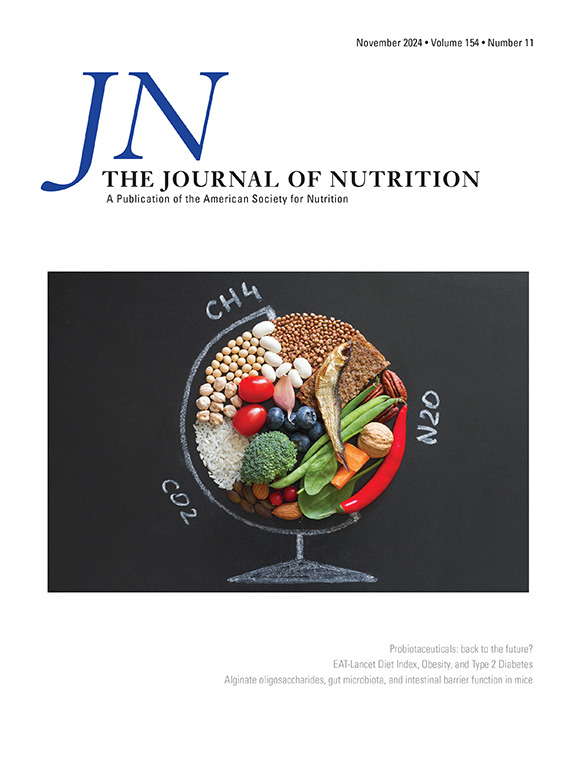Neighborhood Retail Food Environment, Diet Quality and Type 2 Diabetes Incidence in 4 Dutch Cohorts
IF 3.8
3区 医学
Q2 NUTRITION & DIETETICS
引用次数: 0
Abstract
Background
Current evidence on the associations between the food environment and type 2 diabetes (T2D) is inconsistent and did not investigate the behavioral mediating pathway.
Objectives
To investigate whether accessibility of food retailers in the residential neighborhood is associated with T2D incidence in 4 Dutch prospective cohorts, and whether this is mediated by diet quality.
Methods
In this prospective multicohort study, we included 4 Dutch cohort studies (ntotal = 10,249). Nearest distances from all participants’ home to supermarkets, fast-food outlets, and green grocers were calculated at baseline (2004–2012). Incidence of T2D during follow-up was assessed with cohort-specific measures. T2D incidence ratios (IRs) adjusted for demographics, lifestyle, and environmental factors were estimated using Poisson regression in each cohort, and results were pooled across cohorts using a random-effects model. In 2 cohorts (n = 7549), mediation by adherence to the Dutch Healthy Diet index 2015 (DHD15-index; range, 0–13) was investigated using linear and Poisson regression analyses.
Results
Over a mean follow-up of 7.5 y, 569 (5.6%) participants developed T2D. Mean(standard deviation [SD]) age in the cohorts ranged from 41.1(12.9) to 67.4(6.8) y. No associations were observed between accessibility of different food retailers and T2D incidence: βsupermarket, 0.02 (−0.01, 0.06); βfast-food, −0.01(−0.04, 0.03); βgreen grocer, 0.01(−0.05, 0.07). Mediation analyses indicated that every 100 m living further from a supermarket or green grocer was associated with lower adherence to DHD15: βsupermarket = −0.1 (95% confidence interval [CI]: −0.3, 0.0) and βgreen grocer = −0.1 (95% CI: −0.1, 0.0), whereas living further away from fast-food associated with higher adherence (βfast-food = 0.1 [95% CI: 0.0, 0.2]). Higher adherence to DHD15 was associated with lower T2D incidence (IR = 0.93 [95% CI: 0.88, 0.99]).
Conclusions
Spatial accessibility of food retailers was not associated with risk of T2D. Nevertheless, consistent associations in hypothesized pathways were observed, such that spatial accessibility to healthier food retailers was associated with higher diet quality and spatial accessibility of unhealthier retailers with lower diet quality. Higher diet quality, in turn, was associated with lower T2D risk.
四个荷兰队列的社区零售食品环境、饮食质量和2型糖尿病发病率
背景:目前关于食物环境与2型糖尿病(T2D)之间关系的证据不一致,并且没有研究行为介导途径。目的:在四个荷兰前瞻性队列中,调查居民区食品零售商的可及性是否与T2D发病率相关,以及这是否与饮食质量有关。设计:在这项前瞻性多队列研究中,我们纳入了4项荷兰队列研究(ntotal= 10249)。从所有参与者家到超市、快餐店和绿色食品杂货店的最近距离以基线(2004-2012年)计算。随访期间采用队列特异性措施评估T2D的发生率。在每个队列中使用泊松回归估计经人口统计学、生活方式和环境因素调整后的T2D发病率(IR),并使用随机效应模型将结果汇总到各个队列中。在两个队列(n=7,549)中,采用线性和泊松回归分析研究了遵守荷兰健康饮食指数2015 (dhd15指数,范围0-13)的中介作用。结果:在平均7.5年的随访中,569名(5.6%)参与者发生了T2D。队列中的平均(SD)年龄为41.1(12.9)至67.4(6.8)岁。β超市:0.02(-0.01;0.06),β快餐:-0.01(-0.04;0.03),β蔬菜杂货店:0.01(-0.05;0.07),不同食品零售商的可及性与T2D发病率无相关性。中介分析表明,离超市或绿色食品杂货店每100米远,对DHD15的依从性就越低(β超市=-0.1 (95%CI:-0.3;0.0), β绿色食品杂货店=-0.1 (95%CI:-0.1;0.0)),而离快餐越远,对DHD15的依从性越高(β快餐=0.1 (95%CI: 0.0;0.2))。较高的DHD15依从性与较低的T2D发生率相关(IR=0.93 (95%CI: 0.88;0.99))。结论:食品零售商的空间可达性与T2D风险无关。然而,在假设路径中观察到一致的关联,例如,健康食品零售商的空间可达性与较高的饮食质量有关,而不健康零售商的空间可达性与较低的饮食质量有关。较高的饮食质量反过来又与较低的糖尿病风险相关。
本文章由计算机程序翻译,如有差异,请以英文原文为准。
求助全文
约1分钟内获得全文
求助全文
来源期刊

Journal of Nutrition
医学-营养学
CiteScore
7.60
自引率
4.80%
发文量
260
审稿时长
39 days
期刊介绍:
The Journal of Nutrition (JN/J Nutr) publishes peer-reviewed original research papers covering all aspects of experimental nutrition in humans and other animal species; special articles such as reviews and biographies of prominent nutrition scientists; and issues, opinions, and commentaries on controversial issues in nutrition. Supplements are frequently published to provide extended discussion of topics of special interest.
 求助内容:
求助内容: 应助结果提醒方式:
应助结果提醒方式:


